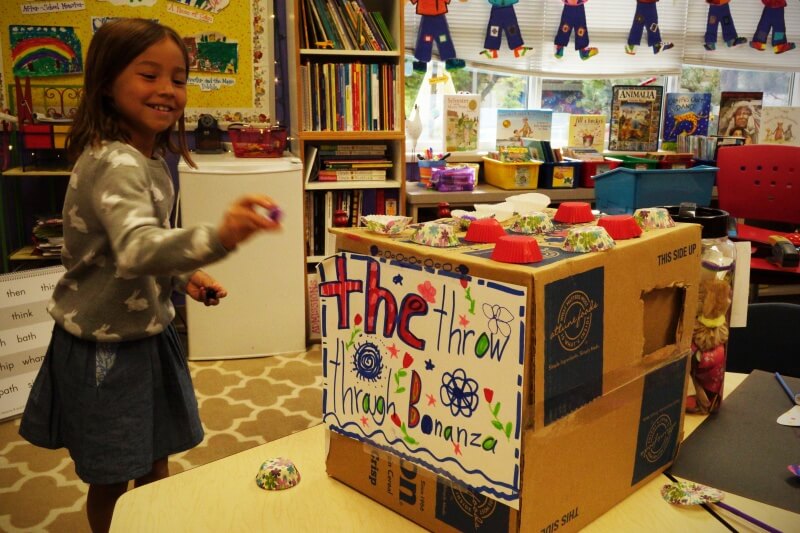When Caine Monroy hits the button that opens his cash register, the drawer pops out with a ding and nearly hits him in the forehead. That’s because Caine is 9 years old and stands about eye-level with the machine. The cash register is located in his father’s used auto parts shop in East Los Angeles, and the reason it’s there has inspired a movement.
Like most cash registers, this one collects money—mostly dollar bills. It sits in what’s known as Caine’s Arcade, an elaborate arcade born in the child’s imagination during a lonely summer where he had to accompany his father to work. To entertain himself, Caine started making arcade games in the front of his father’s auto parts store. More notably, he started making them completely out of cardboard.
Soccer games, basketball games and even a claw machine were up for grabs at Caine’s Arcade, where one dollar buys you four turns, but two dollars buys you a Fun Pass.
“I’m like, well, how many turns do you get with a fun pass?” asks Nirvan Mullick, Caine’s first customer. Mullick answers his own question: “Well, you get 500 turns for a fun pass.” The filmmaker, who made a video promoting Caine’s Arcade, looks around before adding. “I got a fun pass.”
There was only one discernable problem with Caine’s Arcade: Mullick was his only customer. To remedy that, the filmmaker picked up his camera and took to the web to organize a surprise flash mob to surprise Caine with droves of customers. The video that resulted didn’t just tug on the heartstrings of people worldwide, it also started a movement— The Cardboard Challenge, an event presented by the Imagination Foundation which invites kids of all ages to build something amazing out of cardboard in an effort to spur innovation and creativity.
At Colorado Academy, second-grade students are doing just that as they test out their own prototypes inspired by Caine’s Arcade. The room is abuzz with cries of excitement as cardboard contraptions with names like “The Throw- Through Bonanza!” dot the tables.
“What are we trying to accomplish?” asks Lower School teacher Cullen Brink over the din of students. “Well, fun, for sure, as well as creativity, collaboration, organization, and kindness.”
Working in groups, the students design and execute their games, tweaking and perfecting them here and there. From one that features a soccer ball that players catapult into a goal made of tissue-paper, to another that challenges the player to hit a fuzz ball into different cupcake wrappers using a racket made out of pipe cleaners; everything must be made from recycled materials, even the prizes.
“Um, it’s just a straw with some pipe cleaners,” says second-grader Gabriella Myers, looking around the room and tucking her strawberry blonde hair behind her ears. “It’s a prize, but I don’t even know what it is yet.”
As Gabriella demonstrates what her prize can do, others make paper flowers using straws, cardboard and markers, and Brink interrupts the class to tell the students that it’s time to test their games. The students huddle in groups throwing, launching and flinging, and the owner of “The Throw-Through Bonanza” concedes that she should probably make the holes bigger. “Or else it won’t be much fun to play,” she says with a sour smile. Others score goals and adjust their game, and the room erupts in laughter and yelps.
“There’s measuring and balancing and true design thinking here,” says Brink of the students’ work. High fives punctuate the air as she adds, “There’s a lot of feedback, too—they’re working together and supporting each other.”
There’s also trial and error, discussion, and questioning, and genuine learning that’s propelled by an almost tangible excitement.
In the description of the Cardboard Challenge, the Imagination Foundation is careful to say it’s for “kids of all ages”; a distinction that becomes justified on the day all of Lower School—parents, student and teachers—come together to play the games.
On that day, it’s clear the Cardboard Challenge isn’t just for kids. Instead, it’s for those who get lost in solving a problem, who just want to get the fuzz ball in the cupcake wrapper, or collect as many tickets as possible.
It’s for those like Gabriella who want to perfect their game so that it will reach its highest “fun potential,” and for kids who bask in the elation that comes with adults enjoying something they created.
In short, the Cardboard Challenge combines the type of enthusiasm reserved for children with the execution and foresight typical of adults. It isn’t just about taping together some scrap pieces of recycling to make a game—it’s about seeing and realizing the possibilities. As parents and students alike play the games, high-fiving, rejoicing or trying again, those possibilities are palpable, and are as infinite and rewarding as an empty, cardboard box.
Click here to see the Colorado Academy Cardboard Challenge photo gallery.
Below is the video of Caine’s Arcade created by Nirvan Mullick.
